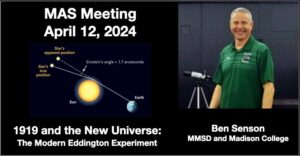1919 and the new Universe… Echos and Beyond, the Modern Eddington Experiment

When Einstein published his general theory of relativity it reinvented one of the most fundamental characteristics of the Universe, and as such it came with predicted phenomena that would settle the issue of whether or not the “King” of Newtonian gravitation was really dead. One of the predictions concerns the existence of a value for the curvature of spacetime based on the presence of mass. Given sufficient mass, like that of a typical yellow G2 star, it was predicted that the “straight line” motion of a beam of light through space-time would have to have this curvature of spacetime itself encoded on its path through a deflection of the observed location of the source of the light compared to an observation made when the massive object was not along the line of sight. In his 1911 paper, “On the Influence of Gravitation on the Propagation of Light” Einstein draws the conclusion that… “A light ray going past the Sun would accordingly undergo deflection by the amount of 0.83 seconds of arc. The angular distance of the star from the center of the Sun appears to be increased by this amount. As the fixed stars in the parts of the sky near the Sun are visible during total eclipses of the Sun, this consequence of the theory may be compared with experimental evidence. … It would be urgently wished that astronomers take up the question here raised, even though the considerations presented above may seem insufficiently established or even bizarre. For, apart from any theory, there is the question of whether it is possible with the equipment at present available to detect an influence of gravitational fields on the propagation of light.” In 1919, during the Solar eclipse on May 29th, astronomers Dyson, Eddington, and Davidson attempted what is now generally referred to as “The Eddington Experiment”, seeking to confirm or challenge the existence of the newly predicted warpage of spacetime. What did they discover? Was the question resolved with this effort? Fast forward to April 8, 2024, and two teams of observers in Mexico and Texas as they take on Einstein’s challenge with modern optics and CMOS detectors in “The Modern Eddington Experiment.” Is it finally time to throw away general relativity? Does solar eclipse data make this theory questionable?? As this description is written before the eclipse, I honestly don’t yet know… but you will be one of the first to hear our suspicions.
Ben Senson is the Planetarium Director for the MMSD Planetarium. He has been an educator for more than 30 years with the Madison Metropolitan School District as a classroom teacher of the Earth sciences, physics, aerospace engineering, and astronomy. At Madison College, he is a senior part-time instructor for physics and astronomy. His work has included numerous published activities in curriculum projects including National Project WET and Project Lead the Way Aerospace Engineering. He is the lead author of “Aerospace Engineering: From the Ground Up” and its accompanying lab manual. His astronomy research has been conducted through the NITARP program and is summarized in the 2023 paper, “Young Stellar Object Candidates in IC 417”. Ben was the founder of Stellar Endeavors Incorporated and brought many astronomy-related products to market including the “Messy Mug,” “AstroCam” and “Guides to the Nighttime Sky.” Ben was the designer and first director of the MMSD Observatory and is currently working on its newest edition to be developed in the MMSD school forest. His most recent read is Kepler’s “The Astronomer and the Witch.”
This meeting will take place in person at our usual Space Place classroom location. It will also be streamed live to our YouTube channel at https://www.youtube.com/@madisonastronomicalsociety.
